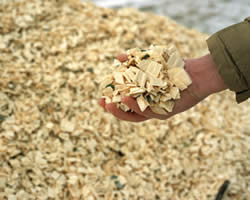Woody Biomass Supply

This page includes information on tools and resources related to woody biomass supply.
The supply of woody biomass varies by region, vegetation (stand composition), treatment objectives, accessibility, market availability, and potential products.
Nationally, there is enough biomass to produce a sustainable supply sufficient to displace 30% or more of the country’s present petroleum consumption (see Billion Ton Report, PDF, 5.5 MB).
Most land managers are interested in how their land can be sustainably managed to supply biomass to local markets.
Normally, the distance from the supply of biomass to the market is inversely proportional to the value of the biomass. The further the material needs to be hauled, the higher the transportation costs.
Tools and Resources
- Billion Ton Report Note: Woody Biomass Feedstock: Providing a Reliable, Predictable Supply (PDF, 13 KB) - Summary of Woody Biomass Feedstocks on Forest Lands.
- Biomass as Feedstock for a Bioenergy and Bioproducts Industry: The Technical Feasibility of a Billion-Ton Annual Supply (PDF, 5.5 MB) - The purpose of the Billion Ton report is to determine whether the land resources of the United States are capable of producing a sustainable supply of biomass sufficient to displace 30 percent or more of the country’s present petroleum consumption.
- Eastern Hardwood Forest Region Woody Biomass Energy Opportunity, October 2007 (PDF, 1.5 MB) - The report examines the woody biomass energy opportunity for the 35 states comprising the Eastern Hardwood Forest Region (EHFR), with the dual objectives of providing an educational overview of the market as it exists today, and offering a baseline reference resource for advanced, targeted feasibility studies within the wood fuel arena.
- EPA Office of Solid Waste - Large amounts of woody biomass are often produced during natural disasters. The EPA provides guidance on natural disaster debris management.
- Regional Biomass Energy Feedstock Partnership Program - The U.S. Departments of Energy and Agriculture, in partnership with the Sun Grant Initiative universities and the members of the National Biomass State and Regional Partnership, have established the Regional Biomass Energy Feedstock Partnership. The Partnership consists of five separate regions: Southeast, North Central, South Central, Western, and Northeast. The overarching goal of the Partnership is to develop biomass feedstock resources on a regional basis in order to realize each region’s potential contribution to the 1.3 billion ton annual biomass feedstock goal, as identified in the joint study by Departments of Energy and Agriculture Billion Ton Study.
- Coordinated Resource Offering Protocol (CROP) - The U.S. Forest Service and Bureau of Land Management has utilized the CROP model for pilot projects as a means of addressing the growing fuel load problem within major forest systems across the United States.